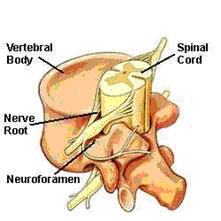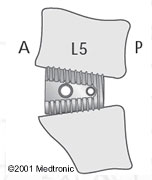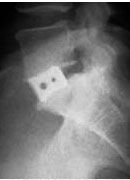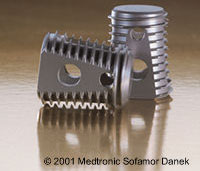|
:::
 |
 |
 |
 |

|
Cage Interbody Fusion |
 |
Cage Interbody Fusion |
|
In recent years the excitement about the development and use of spine cages has escalated. However, unless you are a spine specialist, you may find it difficult to appreciate what all the commotion is about. Lets face it, for most people, spine cages are not an everyday topic of conversation. Most people do not know what spine cages are, how they are used, and how they benefit patients.
To begin, a brief introduction to cages is needed to help you understand why these devices are so important in spine surgery today ... and tomorrow.
|
 |
Cages: An Overview |
|
 Lost disc height is restored when the cages, packed with bone graft are inserted into the space between the two vertebrae. Basically what happens is the bone graft, which has been neatly packed into and around the cages, begins to grow through the perforated walls of the cages eventually forming a solid bond (or 'fusion') holding the vertebrae together. This process is known as 'interbody fusion.' You could loosely compare cages to building blocks and bone graft to the mortar that binds the structure together. The end result is fusion, a strong and stable construct. Lost disc height is restored when the cages, packed with bone graft are inserted into the space between the two vertebrae. Basically what happens is the bone graft, which has been neatly packed into and around the cages, begins to grow through the perforated walls of the cages eventually forming a solid bond (or 'fusion') holding the vertebrae together. This process is known as 'interbody fusion.' You could loosely compare cages to building blocks and bone graft to the mortar that binds the structure together. The end result is fusion, a strong and stable construct.
  After securing the basket in place, it was packed with the horse's own bone graft. In time the bone graft grew into and around the basket creating a solid fusion. After securing the basket in place, it was packed with the horse's own bone graft. In time the bone graft grew into and around the basket creating a solid fusion.
|
 |
The Next Generation of Cages Today |
 |
|
 In recent years cages have undergone numerous modifications to improve their effectiveness. Some of these cages include the BAK? , Ray TFC? , the Contact Fusion Cage? , and INTER FIX? In recent years cages have undergone numerous modifications to improve their effectiveness. Some of these cages include the BAK? , Ray TFC? , the Contact Fusion Cage? , and INTER FIX?
Although, as a patient, you don't need to understand all the technical details about cages, we thought we would highlight some basic details about a specific cage. One of the newest and most technically advanced is the LT Cage? . Surgeons are reporting very good results using this cage as a result of its unique design elements. For example:
- The LT Cage? is tapered (similar to a door wedge). This cage's tapered shape helps to restore the spine's correct alignment or curves; an essential goal of spine surgery
- Often surgeons use two cages next to each other in surgery. The problem in the past has been the curved sides of cages make it difficult to get the cages close together. The LT Cage? has flat sides, meaning that cages can be placed very close together. This might sound like a small change, but it is an important development to help cages succeed in creating strong constructs.
- The perforations or holes in the cage walls are larger thus helping create fusion by allowing for increased bony growth in and around the cage.
- The LT Cage ? is titanium, which makes it very strong and durable. There are no reported cases of an LT Cage? failing structurally. In addition, its titanium construction allows the cage to be seen by CT or MRI scanning.
|
 |
Will a Cage be Used in Your Surgery? |
|
Hundreds of thousands of people suffer from degenerative disc disease, disc herniation or low-grade spondylolisthesis. Thankfully, surgery is not necessary for the vast majority of patients as non-surgical treatments most often provide relief from symptoms. However, for those patients who do require surgery, we hope this article will help you better understand what the surgeon means when he discusses your surgical options and refers to using cages. If you want to learn more about cages, see the links following this article. |
|
 |
|
Risks for this surgery are associated with the use of general anesthesia, the spinal problem itself, or other medical problems. Specific risks include:
- Deep wound infection.
- Blood clots in deep veins.
- Superficial infection.
- ears in the membrane (dura mater) that surrounds the brain and spinal cord.
People who have spinal fusion (arthrodesis) are at higher risk for complications during and after surgery.
|
|
 |
|
 |